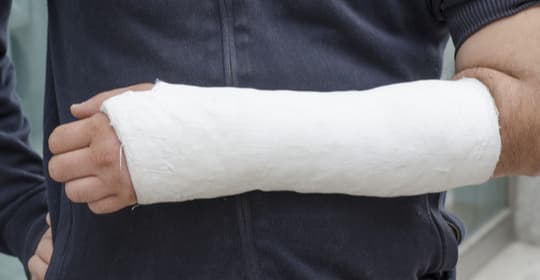What Is a Fracture Nonunion?
A nonunion is a broken bone that has not healed. Most fractures—broken bones—will heal effectively with standard treatment in about 6 to 12 weeks. Between 5 and 10 percent, however, may fail to heal completely.
Nonunited fractures are different from malunited fractures; a fracture malunion occurs when a broken bone heals in an abnormal position.
How Bones Heal
When a bone breaks, the body immediately goes to work trying to heal it. Fractures heal in three stages:
- Inflammatory phase
- Repair phase
- Remodeling phase
In the inflammatory stage, blood and immune system cells rush to the area to begin the healing process. Immune cells clear out disrupted blood, bone fragments and other signs of damage. The area around the broken bone is flooded with blood, fluid and immune cells, resulting in inflammation. This stage peaks a few days after the injury, can last for weeks, and is responsible for most of the pain and swelling after a broken bone.
The repair stage overlaps with the inflammatory stage. The body builds a callus made of immature bone to stabilize the broken ends of bones. At first, this callus is soft and rubbery and doesn’t contain calcium. This is why the early stages of fracture healing don’t show up on an x-ray.
Eventually, the body enters the remodeling stage. That’s when calcium starts to enter the callus, and the callus becomes more mature bone tissue. This remodeling stage can last months, but when the fracture is fully healed it may be almost undetectable.
What Causes a Fracture Nonunion?
Nonunion of fractures happen when this process gets disrupted. Fractures need three things to heal:
- Stability
- Blood supply
- Nutrients
A nonunion can happen if there is too much motion at the fracture site, if there’s an inadequate blood supply or if it is disrupted (such as if the injury that caused the fracture also severely damaged blood vessels in the area), or if the fracture doesn’t get enough nutrients such as calcium or vitamin D during healing, or any combination of these causes.
Nonunion Fracture Risk Factors
Certain lifestyle factors and types of injuries make a nonunion more likely to occur. Some of these can include:
- Smoking, Vaping, and Nicotine Products: Any type of nicotine use makes fractures heal more slowly and makes nonunion fractures more likely.
- High-energy Injuries: High-energy injuries that cause fractures—car accidents are the most common, but falls from height would qualify as well—result in more nonunion fractures than other traumatic events because they’re more likely to damage blood vessels and surrounding tissue and disrupt blood supply.
- Open Fractures: Open fractures—those where at least one end of the fractured bone breaks the skin—may be more likely to cause nonunions because of the damage to the blood supply.
- Lower Vitamin D Level: Vitamin D is important in bone formation. It provides a critical assist to calcium absorption. Less vitamin D means less calcium gets absorbed from diet or supplements, and less calcium may impede callus and bone creation (osteogenesis).
- Diabetes: Type 2 diabetes affects bone healing in a number of ways. People with diabetes create new blood vessels in bone more slowly, have higher levels of damaging inflammation and produce fewer bone cells.
- Osteoporosis: Bone tissue gets continually renewed throughout the lifecycle. When bone tissue is destroyed faster than it can grow back, that’s a condition known as osteoporosis. Osteoporosis increases the risk of fractures, and also makes nonunions after a fracture more likely.
- Infection: Infections at a fracture site can divert the body’s resources from healing the fracture to fighting off the infection, which may result in nonunion or delayed union.
Treatment for Nonunion Fractures
Nonunion fractures that cause symptoms often need to be fixed. Some can be treated nonsurgically, whereas others will require surgery. Nonsurgical treatments for nonunion fractures can include:
- Calcium and Vitamin D Supplementation: If blood tests reveal low levels of calcium or vitamin D, supplementing these minerals may improve healing.
- Infection Treatment: Antibiotics to clear an infection may allow the body to start healing the fracture.
- Smoking Cessation: Quitting smoking will speed fracture healing.
- Controlling Diabetes: Diabetes works on multiple levels to impede fracture healing. Controlling diabetes has a host of health benefits, including better healing of broken bones.
Surgical treatment may be necessary if nonoperative treatment is ineffective. Surgical and nonsurgical treatment may also be combined. Many surgeons will treat nonunions by resetting the bone with internal fixation, using plates, screws or nails to keep the broken ends of the bone lined up with each other (reduced) and adding bone graft to improve healing at the fracture site.
One common technique is affixing a plate that spans the fracture and is held in place by screws on either side of the broken bone. Another is known as an intramedullary nail, which is a rod that’s inserted through the middle of a bone and unites the two broken ends.
If you have pain from a fracture that occurred longer than 6 to 12 weeks ago, you may have a nonunion or delayed union. Request an appointment at UOA. Our trauma and fracture specialists can determine why your fracture isn’t healing and take steps to repair it.





